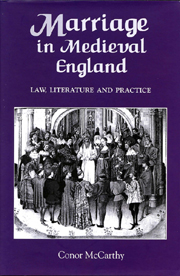Introduction
Published online by Cambridge University Press: 12 September 2012
Summary
Literature, law and marriage
This book is about marriage in medieval England, the ways in which marriage is represented in medieval English legal and literary texts, and the relationship of these representations to actual practice. Both legal and literary texts have a great deal to say on the subject of marriage, and therefore provide us with a rich source of evidence. Where English legal writings are concerned, texts from the seventh-century laws of Æthelbert onwards contain regulations concerning marriage, albeit cryptically expressed, and later Anglo-Saxon laws show the influence of developing ecclesiastical thinking on marriage. From the point where William the Conqueror divides the ecclesiastical and secular jurisdictions, we see two sets of law intervening in marriage: the ecclesiastical courts take control of marriage in all of its spiritual aspects, leaving the secular jurisdiction to judge only those aspects of marriage relating to property and the inheritance of landed property. As for literature, it is true that literary writing on marriage from the early medieval period is thin. As Christine Fell observes, ‘neither sex nor marriage is central to Old English literature, and romance plays a very small part.’ Nonetheless, evidence offered in passing by Old English poems such as Beowulf and The Wanderer can be illuminating on topics that are not their central concern. In the later Middle Ages, topics such as sex, marriage, and romance are a central concern: as David Lampe comments, ‘Old English (or, if you prefer, Anglo-Saxon) seems to show very little interest in sex and Middle English has almost too much.’
- Type
- Chapter
- Information
- Marriage in Medieval EnglandLaw, Literature and Practice, pp. 1 - 18Publisher: Boydell & BrewerPrint publication year: 2004



